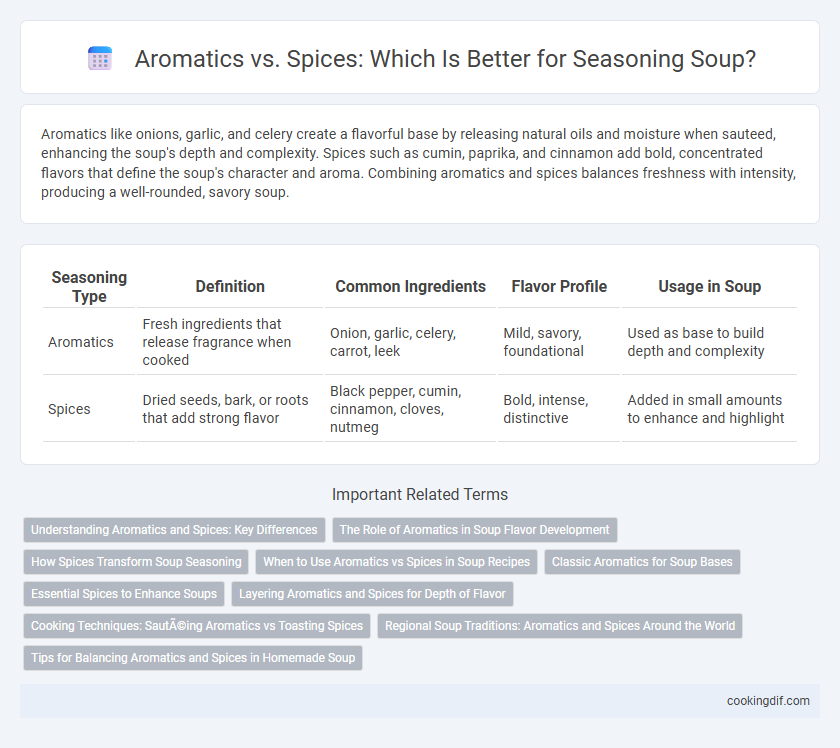Aromatics like onions, garlic, and celery create a flavorful base by releasing natural oils and moisture when sauteed, enhancing the soup's depth and complexity. Spices such as cumin, paprika, and cinnamon add bold, concentrated flavors that define the soup's character and aroma. Combining aromatics and spices balances freshness with intensity, producing a well-rounded, savory soup.
Table of Comparison
| Seasoning Type | Definition | Common Ingredients | Flavor Profile | Usage in Soup |
|---|---|---|---|---|
| Aromatics | Fresh ingredients that release fragrance when cooked | Onion, garlic, celery, carrot, leek | Mild, savory, foundational | Used as base to build depth and complexity |
| Spices | Dried seeds, bark, or roots that add strong flavor | Black pepper, cumin, cinnamon, cloves, nutmeg | Bold, intense, distinctive | Added in small amounts to enhance and highlight |
Understanding Aromatics and Spices: Key Differences
Aromatics such as onions, garlic, and celery provide foundational flavors through their natural moisture and subtle complexity, essential for building soup bases. Spices like cinnamon, cumin, and pepper deliver concentrated, potent notes that enhance depth and add distinctive character to soups. Recognizing the roles of aromatics versus spices enables precise flavor layering and balanced seasoning in culinary soup preparations.
The Role of Aromatics in Soup Flavor Development
Aromatics such as onions, garlic, celery, and carrots form the foundational flavor base in soups by releasing essential oils and natural sugars during sauteing, which enhances the soup's depth and complexity. These ingredients undergo Maillard reactions that create rich, savory flavors crucial for a well-rounded broth. Incorporating aromatics early in the cooking process allows their subtle nuances to meld with other components, elevating the overall taste profile beyond what spices alone can achieve.
How Spices Transform Soup Seasoning
Spices infuse soup with complex, layered flavors that aromatics alone cannot achieve, enhancing depth and warmth through compounds like essential oils and volatile phenols. Unlike aromatics such as onions or celery, spices like cumin, coriander, and cloves bring a robust, concentrated punch that evolves throughout the cooking process, intensifying the broth's richness. Their potent bioactive compounds stimulate the palate and unlock new taste dimensions, making spices indispensable for crafting bold, memorable soups.
When to Use Aromatics vs Spices in Soup Recipes
Aromatics such as onions, garlic, and celery release their flavors slowly and are best added at the beginning of soup cooking to build a deep, savory base. Spices like cumin, cinnamon, or chili powder have more concentrated flavors and are ideal for adding mid-cooking or near the end to enhance and layer the taste profile. Understanding when to incorporate aromatics versus spices ensures balanced seasoning and a complex, well-rounded soup.
Classic Aromatics for Soup Bases
Classic aromatics such as onions, garlic, celery, and carrots form the essential flavor foundation for soup bases, delivering depth and complexity through their natural sweetness and savory notes. These ingredients undergo slow sauteing or sweating to release enzymes that enhance the soup's overall aroma and richness. Unlike spices, which introduce bold, often sharp or pungent flavors, aromatics provide a balanced and subtle backbone that harmonizes multiple soup elements while allowing core ingredients to shine.
Essential Spices to Enhance Soups
Essential spices for enhancing soups include cumin, coriander, black pepper, and turmeric, which add depth and warmth to the broth. Aromatics like garlic, onions, and celery provide a flavorful base, while spices bring complexity and boldness to the taste profile. Combining both aromatics and essential spices creates a balanced, richly seasoned soup with layered flavors that captivate the palate.
Layering Aromatics and Spices for Depth of Flavor
Layering aromatics such as onions, garlic, and celery at the beginning of soup preparation builds a robust flavor foundation. Introducing spices like cumin, coriander, and bay leaves during cooking enhances complexity by releasing essential oils gradually. This technique maximizes depth of flavor, creating a well-rounded and aromatic soup profile.
Cooking Techniques: Sautéing Aromatics vs Toasting Spices
Sauteing aromatics like onions, garlic, and celery in oil releases their natural flavors, creating a tender, fragrant base essential for soups. Toasting spices such as cumin, coriander, or cloves in a dry pan intensifies their oils and enhances their aroma, adding depth and complexity without bitterness. Combining both techniques elevates soup seasoning by layering fresh, vibrant notes with rich, toasted spice profiles.
Regional Soup Traditions: Aromatics and Spices Around the World
Regional soup traditions showcase a diverse use of aromatics and spices, with Southeast Asian soups often incorporating lemongrass, galangal, and kaffir lime leaves to create layered flavors, while Middle Eastern varieties rely on cumin, coriander, and cinnamon to add warmth and depth. In Western European soups, aromatics like onions, garlic, and carrots form the flavor base, complemented by herbs such as thyme and bay leaves, whereas South American soups feature bold spices like aji peppers and cilantro for vibrant zest. Understanding these regional flavor profiles is essential for crafting authentic soups that balance aromatic freshness with the intensity of spices.
Tips for Balancing Aromatics and Spices in Homemade Soup
Balancing aromatics and spices in homemade soup involves layering flavors by starting with onions, garlic, and celery to build a savory base while gradually adding spices such as cumin, coriander, or paprika for depth. To avoid overpowering the broth, introduce spices early in the cooking process to allow mellowing and infusion, and taste frequently to adjust intensity. Fresh herbs like thyme or bay leaves complement the aromatics without overwhelming the spices, creating a harmonious and complex soup flavor profile.
Aromatics vs Spices for seasoning Infographic

 cookingdif.com
cookingdif.com